Dates for your Diary
Pokemon Hunt running throughout school holidays 50p per child.
Museum opening times
The Museum is open to the public, free of charge:
Thursday* to Saturday 10am – 1pm
July 100 Club
This month’s prize numbers were drawn by members Margaret Dyer and Gaynor Tucker and the lucky winners are:-
No. 80 Margaret Cook £20
No. 33 Jean Colwell £10
If you would like to join our 100 club and be in with a chance of winning, it costs just £1 a month. Ask at the museum for further details.
Thank You
We are very grateful to Councillor Malcolm Day, who represents the Cwmtillery ward at Blaenau Gwent County Borough Council, for his very generous donation of £50.
Clytha Garden
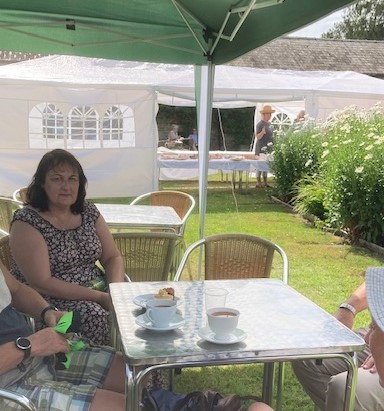 The open garden day at the home of our President, Mr Jack Hanbury, went well with a good turnout in spite of the exceptional heat.
The open garden day at the home of our President, Mr Jack Hanbury, went well with a good turnout in spite of the exceptional heat.
We even met other visitors there from Abertillery including museum member Susan Davies pictured here enjoying afternoon tea and cakes.
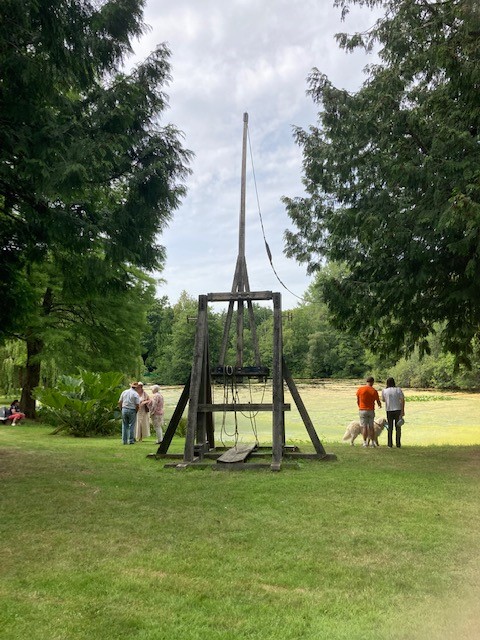
Having watched the dog show, we walked off the afternoon tea with a stroll around the lake and were impressed with the ancient giant catapult that stands on the edge of the lake.
 Pokemon Hunt!
Pokemon Hunt!
Every week, Pikachu and his friends are finding new places to hide and we need help to find them! Running from now until September, 50p per child.
Happy Birthday
Not one but two of our members recently celebrated their 80th birthdays! Please join with me in wishing Gillian Yemm and Peter Rosser all the best for the year ahead.
England’s Ghost Town
Ghost towns have featured in this newsletter before, Chernobyl in Ukraine (April edition 2021) and Varosha in Cyprus (June 2021) but it wasn’t until recently that I realised we have our very own ‘ghost town’ right here in the UK. I’m referring to Tyneham, an English village on the south coast of Devon…
In December 1943, with the country still at war with Nazi Germany, the village and 7500 acres of surrounding land, was requisitioned by the War Office (now the Ministry of Defence). They wanted to use it as a firing range to train troops. It meant 225 people were displaced and before leaving a note was left on the church door which read:
Please treat the church and houses with care; we have given up our homes where many of us have lived for generations to help win the war to keep men free. We shall return one day and thank you for treating the village kindly.
It was only ever supposed to be a temporary arrangement but in 1948, three years after the war had ended, the Army placed a compulsory purchase order on the village and it was used for practice shelling.
By 1967, with the site having fallen into disrepair, most of the 14th century manor house was demolished. St Mary’s church, though with its stained-glass window by Martin Travers, remains largely intact.
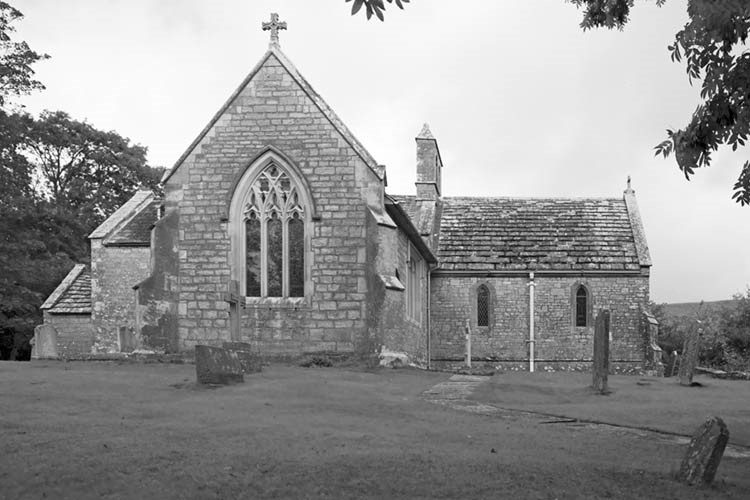
By WyrdLight.com, CC BY-SA 3.0,
By 1975, after protests from locals and tourists, the MOD began opening the village and some of the footpaths across the site on certain weekends and throughout August. Today it is littered with debris and scrap but has become a haven for wildlife and the church and school house (see photos) have both been preserved as museums and given Grade II listed status along with the village drinking fountain.
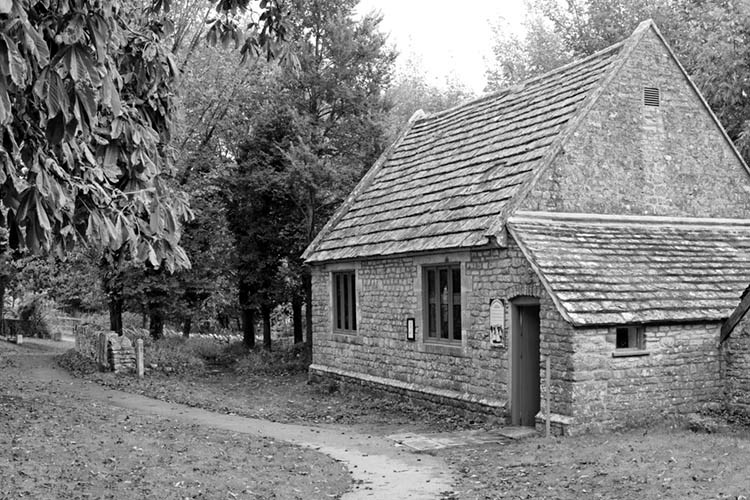
By WyrdLight.com, CC BY-SA 3.0
The village has also been used in a number of film settings including the filming of Comrades (1985) which tells the story of the Tolpuddle Martyrs as well as being the setting for the 2019 book The Forgotten Village by Lorna Cook.
For more information click here
Sally Murphy
Outside Exhibits
 Like with the ‘hidden drawers’ featured in June’s edition, I only realised of late that there are exhibits outside the museum too. Pictured here is our horse trough and above, a blacksmiths anvil used for the making of wagon wheels. It was discovered by a Mr I J Cole of Park Place, who unearthed it while making a hard standing for his car and who kindly donated it to the museum.
Like with the ‘hidden drawers’ featured in June’s edition, I only realised of late that there are exhibits outside the museum too. Pictured here is our horse trough and above, a blacksmiths anvil used for the making of wagon wheels. It was discovered by a Mr I J Cole of Park Place, who unearthed it while making a hard standing for his car and who kindly donated it to the museum.
Take a look on your next visit and watch out for the hoof prints!
Eyam
We thought we had it tough with the lockdowns of 2020 but it pales in comparison to the suffering of the villagers of Eyam in 1666…
Eyam is a small English village in the Derbyshire Dales, about 30 miles southeast of Manchester. In May 1665 a bundle of cloth arrived in Eyam from London for Alexander Hadfield, the local Tailor. His assistant, George Viccars, noticing the bundle was damp, opened it up. Within a week George was dead. The Great Plague had arrived in Eyam.
The disease spread around the village quickly and in desperation the villagers turned to their clergy for guidance. They put in place a number of things to help stop the spread. Firstly they moved church services to a large amphitheatre to allow the villagers to spread themselves out (sounds familiar?) and they also introduced an arrangement whereby the villagers buried their own dead. But perhaps the biggest single thing they did was to decide to quarantine the whole village.
They encircled the entire village with stones and made a pact that none of them would set foot beyond the stones, even those showing no symptoms. There is some debate over how well this decision by the village leaders was received, with some folk trying to flee the village, but the majority accepted their fate. It must be said that it was an incredibly brave decision as it meant the healthy were trapped along with the infected with many of them facing a certain (and unpleasant) death.
They had an arrangement with neighbouring communities to leave coins soaked in vinegar (in the hope of disinfecting the coins) in holes bored in the stones and in return they would receive food parcels.
With little understanding of viruses and certainly no vaccine, the plague ripped through the community and as more and more died so the village began to fall into disrepair. Roads went unrepaired and gardens became overgrown. Out of a population of around 350, over 270 died. One of the first symptoms of infection was that your sense of smell changed. Often plague carriers would notice a strange sweet odour. In reality what they were smelling was their own rotting internal organs!
One of the survivors was Elizabeth Hancock. She never had any symptoms despite having to bury her husband and her six children. She would tie ropes around their ankles and drag their bodies to a nearby field where the grave digger, Marshall Howe, who also survived, would be waiting. And after the village stonemason died, they even had to engrave their own tombstones.
Fourteen months after the plague arrived in Eyam it had run its course and vanished. Probably because all it could infect either had immunity to it or had had it and died. The bravery shown by the villagers of Eyam over 350 years ago helped stop the spread of the disease and certainly puts our recent hardships into perspective!
The village church in Eyam has a list of 273 victims of the plague and at Eyam Museum you can learn much more about the plight of the villagers and how they dealt with the situation they found themselves in and some of the boundary stones remain in place to this day such as the one photographed here.
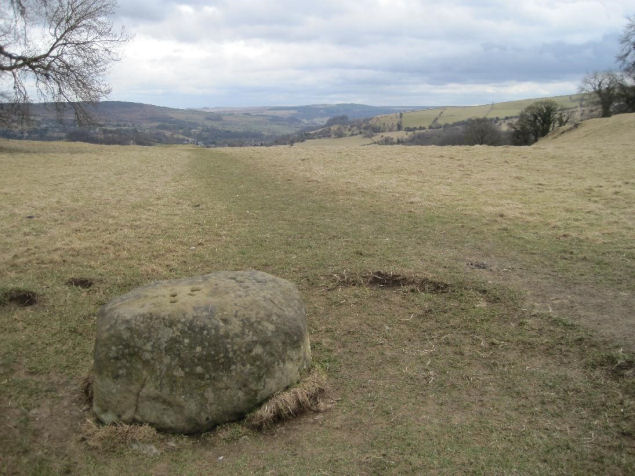
By Smb1001 - Own work, CC BY-SA 3.0
For more information use these links:
BBC Artical
Eyam Museum
Wikipedia
Sally Murphy
Holiday Booking Scams
It was on the news recently that the UK is the most targeted country in the world for scams, and if, like me, you’re hoping to get away for a holiday later this year but have so far resisted booking due to airport chaos etc, then extra vigilance is needed now so that we don’t fall victim to these crooks who are out to steal our money…
Often scammers will ‘steal’ legitimate photos of real places, villas for example, from real websites and then use them on their own ‘fake’ website. There have been cases where unsuspecting consumers have booked a villa and then flown out only to find it doesn’t exist. And even if you suspect you have been scammed before you fly, insurance companies will not usually refund you until you’ve proved, to their satisfaction, that you have indeed been scammed and this often means getting on that plane knowing you will have nowhere to stay when you get there!
Scammers often use spoof websites where they copy real companies like AirBNB or Expedia and then make very subtle changes to the URL (website address), like one extra letter for example, so that it looks and feels like the genuine website.
So how can you protect yourself?
Firstly, your best option is to pay using a credit card. As long as the purchase price is over £100, even if you only pay one penny on the card, then the whole purchase is protected under Section 75 of the Consumer Credit Act. Paying by debit card also gives you protection against fraud through your bank but NEVER EVER pay by bank transfer. Bank transfer is no different to handing over cash and gives you no protection and it should only be used to pay someone you know and trust. So if someone tells you that the only option to secure that ‘fantastic deal’ is to pay by Bank Transfer, walk away! And that goes for anything not just holidays!
Secondly, beware really cheap prices. If something seems too good to be true then it usually isn’t true!
Thirdly, research thoroughly before buying your holiday. Search for reviews of the website or person online using websites such as Trustpilot. Check that the holiday website begins with HTTPS (the S is for secure) and that it has a closed padlock in the website address bar. If you’re given an address for the holiday let, check it exists using Google Maps. Be aware though it may well exist but when you arrive you might find it occupied by someone who has genuinely booked the property.
Finally, try to book a package holiday (accommodation and flights) through a travel agent who is ABTA or ATOL protected. This can be done in person on the High Street or through a website. A package will give you that extra protection and means the company are responsible for getting you there, looking after you while you’re there and getting you home safely. And if they can’t do this then you will get a full refund. As soon as you pay your deposit you should immediately receive your ATOL or ABTA certificate. Keep this safe as you will need it should things go wrong.
In summary
- Pay on a credit card even if just the deposit
- Beware cheap prices
- Check the website is secure
- Book an ABTA / ATOL package and keep your certificate safe
Happy holiday!

For more advice on avoiding scams use this link
Top Of Page
